GMC SIERRA 2017 Owner's Manual
Manufacturer: GMC, Model Year: 2017, Model line: SIERRA, Model: GMC SIERRA 2017Pages: 511, PDF Size: 5.21 MB
Page 321 of 511
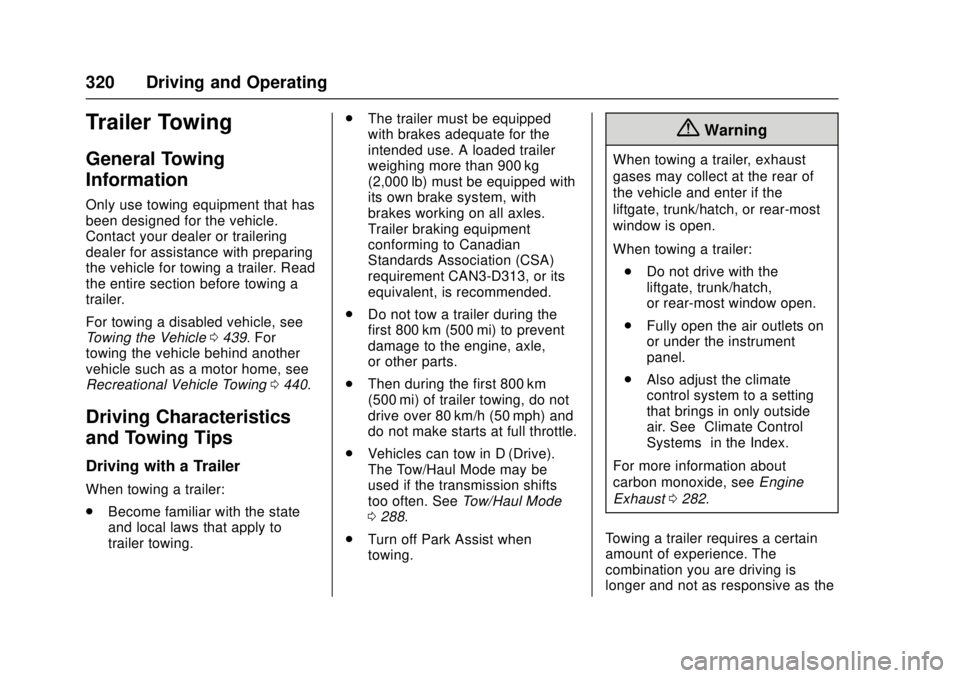
GMC Sierra/Sierra Denali Owner Manual (GMNA-Localizing-U.S./Canada/
Mexico-9955992) - 2017 - crc - 4/18/17
320 Driving and Operating
Trailer Towing
General Towing
Information
Only use towing equipment that has
been designed for the vehicle.
Contact your dealer or trailering
dealer for assistance with preparing
the vehicle for towing a trailer. Read
the entire section before towing a
trailer.
For towing a disabled vehicle, see
Towing the Vehicle0439. For
towing the vehicle behind another
vehicle such as a motor home, see
Recreational Vehicle Towing 0440.
Driving Characteristics
and Towing Tips
Driving with a Trailer
When towing a trailer:
.
Become familiar with the state
and local laws that apply to
trailer towing. .
The trailer must be equipped
with brakes adequate for the
intended use. A loaded trailer
weighing more than 900 kg
(2,000 lb) must be equipped with
its own brake system, with
brakes working on all axles.
Trailer braking equipment
conforming to Canadian
Standards Association (CSA)
requirement CAN3-D313, or its
equivalent, is recommended.
. Do not tow a trailer during the
first 800 km (500 mi) to prevent
damage to the engine, axle,
or other parts.
. Then during the first 800 km
(500 mi) of trailer towing, do not
drive over 80 km/h (50 mph) and
do not make starts at full throttle.
. Vehicles can tow in D (Drive).
The Tow/Haul Mode may be
used if the transmission shifts
too often. See Tow/Haul Mode
0 288.
. Turn off Park Assist when
towing.
{Warning
When towing a trailer, exhaust
gases may collect at the rear of
the vehicle and enter if the
liftgate, trunk/hatch, or rear-most
window is open.
When towing a trailer:
. Do not drive with the
liftgate, trunk/hatch,
or rear-most window open.
. Fully open the air outlets on
or under the instrument
panel.
. Also adjust the climate
control system to a setting
that brings in only outside
air. See “Climate Control
Systems” in the Index.
For more information about
carbon monoxide, see Engine
Exhaust 0282.
Towing a trailer requires a certain
amount of experience. The
combination you are driving is
longer and not as responsive as the
Page 322 of 511

GMC Sierra/Sierra Denali Owner Manual (GMNA-Localizing-U.S./Canada/
Mexico-9955992) - 2017 - crc - 4/18/17
Driving and Operating 321
vehicle itself. Get acquainted with
the handling and braking of the rig
before setting out for the open road.
The structure, tires, and brakes of
the trailer must be rated to carry the
load. Inadequate trailer equipment
can cause the combination to
operate in an unexpected or unsafe
manner.
Before starting, check all trailer hitch
parts and attachments, safety
chains, electrical connectors, lamps,
tires, and mirrors. Get familiar with
the handling and braking of the rig.
If the trailer has electric brakes, start
the combination moving and then
apply the trailer brake controller by
hand to be sure the brakes work.
During the trip, check occasionally
to be sure that the load is secure
and the lamps and any trailer
brakes still work.
Following Distance
Stay at least twice as far behind the
vehicle ahead as you would when
driving the vehicle without a trailer.
This can help to avoid heavy
braking and sudden turns.
Passing
More passing distance is needed
when towing a trailer. The
combination will not accelerate as
quickly and is longer so it is
necessary to go much farther
beyond the passed vehicle before
returning to the lane.
Backing Up
Hold the bottom of the steering
wheel with one hand. To move the
trailer to the left, move that hand to
the left. To move the trailer to the
right, move your hand to the right.
Always back up slowly and,
if possible, have someone
guide you.
Making TurnsCaution
Making very sharp turns while
trailering could cause the trailer to
come in contact with the vehicle.
The vehicle could be damaged.
Avoid making very sharp turns
while trailering. When turning with a trailer, make
wider turns than normal. Do this so
the trailer will not strike soft
shoulders, curbs, road signs, trees,
or other objects. Avoid jerky or
sudden maneuvers. Signal well in
advance.
If the trailer turn signal bulbs burn
out, the arrows on the instrument
cluster will still flash for turns. It is
important to check occasionally to
be sure the trailer bulbs are still
working.
Driving on Grades
Reduce speed and shift to a lower
gear
before starting down a long or
steep downgrade. If the
transmission is not shifted down, the
brakes might get hot and no longer
work well.
Vehicles can tow in D (Drive). Shift
the transmission to a lower gear if
the transmission shifts too often
under heavy loads and/or hilly
conditions.
The Tow/Haul Mode may be used if
the transmission shifts too often.
See Tow/Haul Mode 0288.
Page 323 of 511
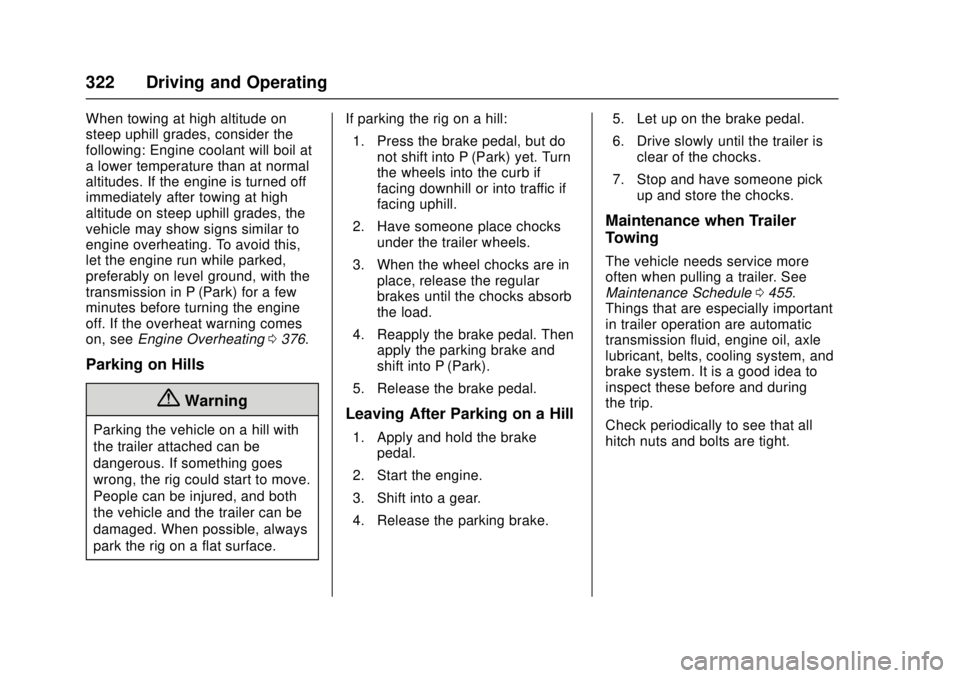
GMC Sierra/Sierra Denali Owner Manual (GMNA-Localizing-U.S./Canada/
Mexico-9955992) - 2017 - crc - 4/18/17
322 Driving and Operating
When towing at high altitude on
steep uphill grades, consider the
following: Engine coolant will boil at
a lower temperature than at normal
altitudes. If the engine is turned off
immediately after towing at high
altitude on steep uphill grades, the
vehicle may show signs similar to
engine overheating. To avoid this,
let the engine run while parked,
preferably on level ground, with the
transmission in P (Park) for a few
minutes before turning the engine
off. If the overheat warning comes
on, seeEngine Overheating 0376.
Parking on Hills
{Warning
Parking the vehicle on a hill with
the trailer attached can be
dangerous. If something goes
wrong, the rig could start to move.
People can be injured, and both
the vehicle and the trailer can be
damaged. When possible, always
park the rig on a flat surface. If parking the rig on a hill:
1. Press the brake pedal, but do not shift into P (Park) yet. Turn
the wheels into the curb if
facing downhill or into traffic if
facing uphill.
2. Have someone place chocks under the trailer wheels.
3. When the wheel chocks are in place, release the regular
brakes until the chocks absorb
the load.
4. Reapply the brake pedal. Then apply the parking brake and
shift into P (Park).
5. Release the brake pedal.Leaving After Parking on a Hill
1. Apply and hold the brake pedal.
2. Start the engine.
3. Shift into a gear.
4. Release the parking brake. 5. Let up on the brake pedal.
6. Drive slowly until the trailer is
clear of the chocks.
7. Stop and have someone pick up and store the chocks.
Maintenance when Trailer
Towing
The vehicle needs service more
often when pulling a trailer. See
Maintenance Schedule 0455.
Things that are especially important
in trailer operation are automatic
transmission fluid, engine oil, axle
lubricant, belts, cooling system, and
brake system. It is a good idea to
inspect these before and during
the trip.
Check periodically to see that all
hitch nuts and bolts are tight.
Page 324 of 511
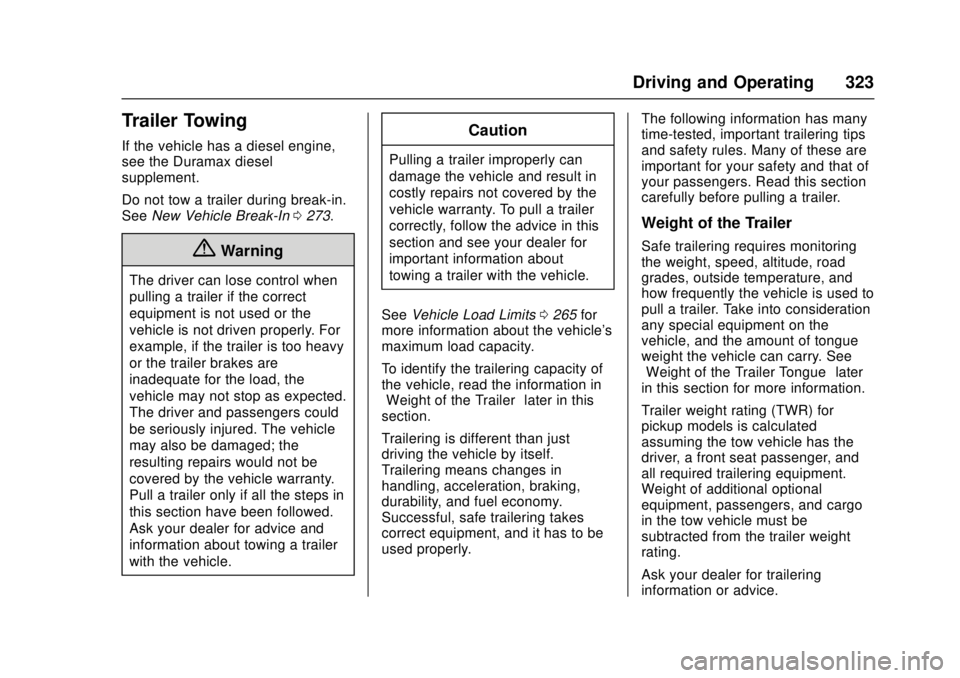
GMC Sierra/Sierra Denali Owner Manual (GMNA-Localizing-U.S./Canada/
Mexico-9955992) - 2017 - crc - 4/18/17
Driving and Operating 323
Trailer Towing
If the vehicle has a diesel engine,
see the Duramax diesel
supplement.
Do not tow a trailer during break-in.
SeeNew Vehicle Break-In 0273.
{Warning
The driver can lose control when
pulling a trailer if the correct
equipment is not used or the
vehicle is not driven properly. For
example, if the trailer is too heavy
or the trailer brakes are
inadequate for the load, the
vehicle may not stop as expected.
The driver and passengers could
be seriously injured. The vehicle
may also be damaged; the
resulting repairs would not be
covered by the vehicle warranty.
Pull a trailer only if all the steps in
this section have been followed.
Ask your dealer for advice and
information about towing a trailer
with the vehicle.
Caution
Pulling a trailer improperly can
damage the vehicle and result in
costly repairs not covered by the
vehicle warranty. To pull a trailer
correctly, follow the advice in this
section and see your dealer for
important information about
towing a trailer with the vehicle.
See Vehicle Load Limits 0265 for
more information about the vehicle's
maximum load capacity.
To identify the trailering capacity of
the vehicle, read the information in
“Weight of the Trailer” later in this
section.
Trailering is different than just
driving the vehicle by itself.
Trailering means changes in
handling, acceleration, braking,
durability, and fuel economy.
Successful, safe trailering takes
correct equipment, and it has to be
used properly. The following information has many
time-tested, important trailering tips
and safety rules. Many of these are
important for your safety and that of
your passengers. Read this section
carefully before pulling a trailer.
Weight of the Trailer
Safe trailering requires monitoring
the weight, speed, altitude, road
grades, outside temperature, and
how frequently the vehicle is used to
pull a trailer. Take into consideration
any special equipment on the
vehicle, and the amount of tongue
weight the vehicle can carry. See
“Weight of the Trailer Tongue”
later
in this section for more information.
Trailer weight rating (TWR) for
pickup models is calculated
assuming the tow vehicle has the
driver, a front seat passenger, and
all required trailering equipment.
Weight of additional optional
equipment, passengers, and cargo
in the tow vehicle must be
subtracted from the trailer weight
rating.
Ask your dealer for trailering
information or advice.
Page 325 of 511
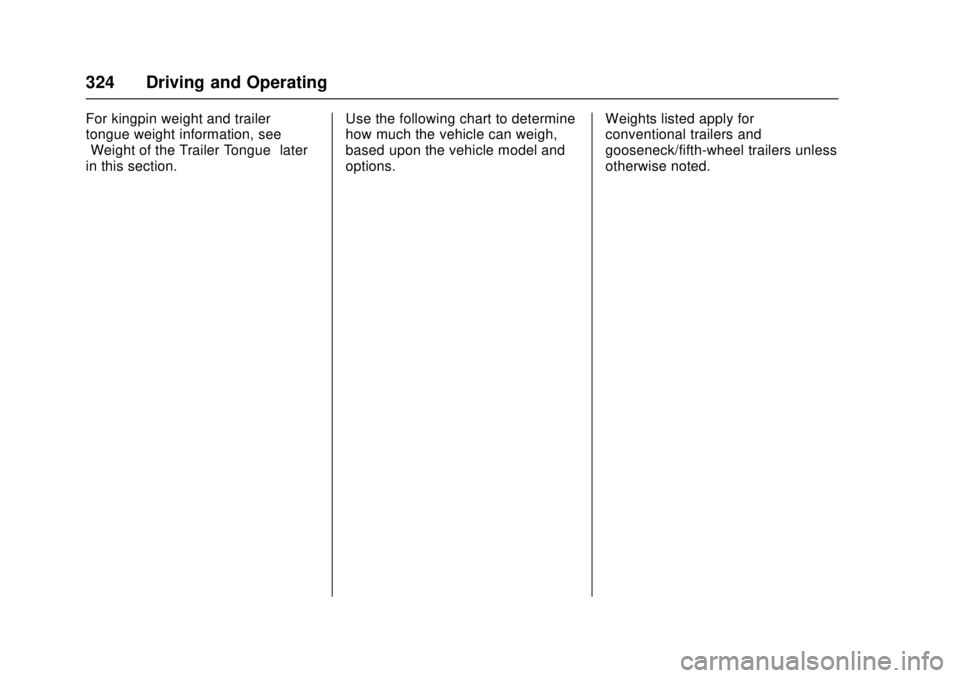
GMC Sierra/Sierra Denali Owner Manual (GMNA-Localizing-U.S./Canada/
Mexico-9955992) - 2017 - crc - 4/18/17
324 Driving and Operating
For kingpin weight and trailer
tongue weight information, see
“Weight of the Trailer Tongue”later
in this section. Use the following chart to determine
how much the vehicle can weigh,
based upon the vehicle model and
options.Weights listed apply for
conventional trailers and
gooseneck/fifth-wheel trailers unless
otherwise noted.
Page 326 of 511
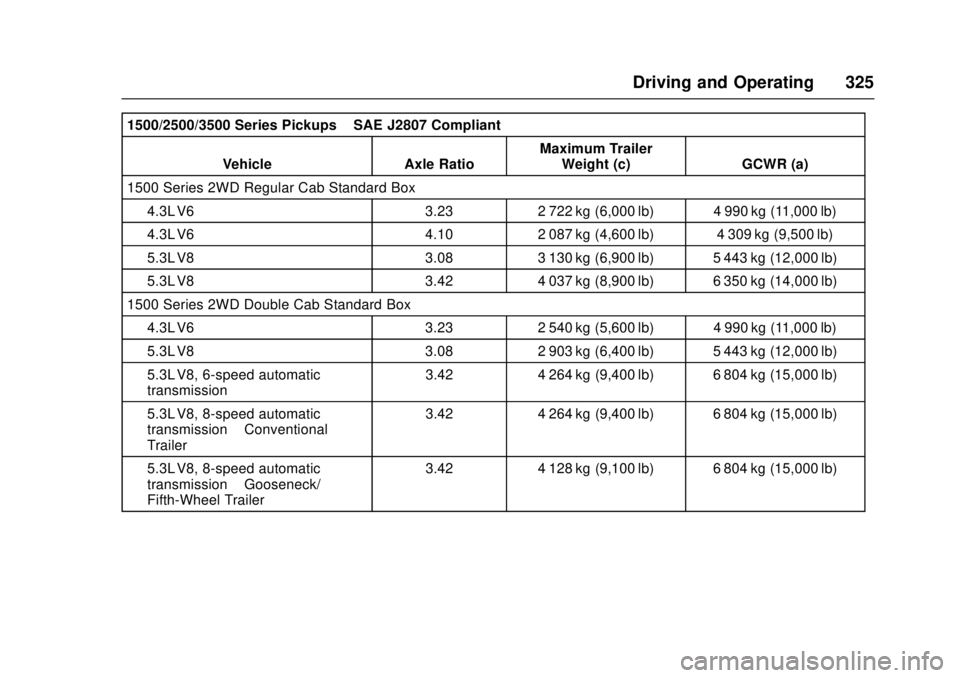
GMC Sierra/Sierra Denali Owner Manual (GMNA-Localizing-U.S./Canada/
Mexico-9955992) - 2017 - crc - 4/18/17
Driving and Operating 325
1500/2500/3500 Series Pickups–SAE J2807 Compliant
Vehicle Axle Ratio Maximum Trailer
Weight (c) GCWR (a)
1500 Series 2WD Regular Cab Standard Box 4.3L V6 3.23 2 722 kg (6,000 lb) 4 990 kg (11,000 lb)
4.3L V6 4.10 2 087 kg (4,600 lb) 4 309 kg (9,500 lb)
5.3L V8 3.08 3 130 kg (6,900 lb) 5 443 kg (12,000 lb)
5.3L V8 3.42 4 037 kg (8,900 lb) 6 350 kg (14,000 lb)
1500 Series 2WD Double Cab Standard Box 4.3L V6 3.23 2 540 kg (5,600 lb) 4 990 kg (11,000 lb)
5.3L V8 3.08 2 903 kg (6,400 lb) 5 443 kg (12,000 lb)
5.3L V8, 6-speed automatic
transmission 3.42 4 264 kg (9,400 lb) 6 804 kg (15,000 lb)
5.3L V8, 8-speed automatic
transmission –Conventional
Trailer 3.42 4 264 kg (9,400 lb) 6 804 kg (15,000 lb)
5.3L V8, 8-speed automatic
transmission –Gooseneck/
Fifth-Wheel Trailer 3.42 4 128 kg (9,100 lb) 6 804 kg (15,000 lb)
Page 327 of 511
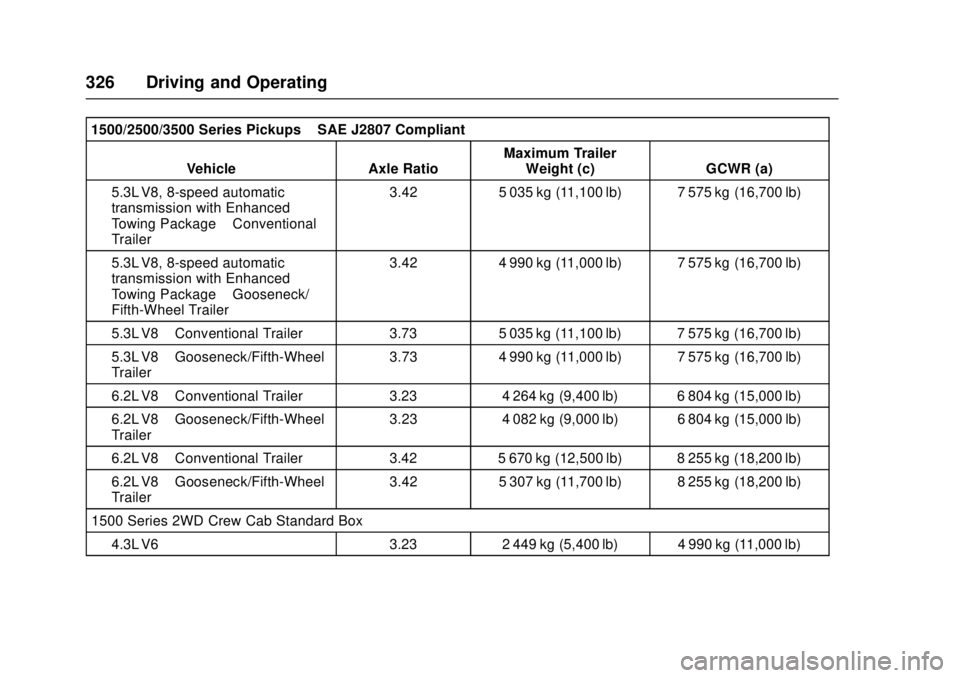
GMC Sierra/Sierra Denali Owner Manual (GMNA-Localizing-U.S./Canada/
Mexico-9955992) - 2017 - crc - 4/18/17
326 Driving and Operating
1500/2500/3500 Series Pickups–SAE J2807 Compliant
Vehicle Axle Ratio Maximum Trailer
Weight (c) GCWR (a)
5.3L V8, 8-speed automatic
transmission with Enhanced
Towing Package –Conventional
Trailer 3.42 5 035 kg (11,100 lb) 7 575 kg (16,700 lb)
5.3L V8, 8-speed automatic
transmission with Enhanced
Towing Package –Gooseneck/
Fifth-Wheel Trailer 3.42 4 990 kg (11,000 lb) 7 575 kg (16,700 lb)
5.3L V8 –Conventional Trailer 3.735 035 kg (11,100 lb) 7 575 kg (16,700 lb)
5.3L V8 –Gooseneck/Fifth-Wheel
Trailer 3.73
4 990 kg (11,000 lb) 7 575 kg (16,700 lb)
6.2L V8 –Conventional Trailer 3.234 264 kg (9,400 lb) 6 804 kg (15,000 lb)
6.2L V8 –Gooseneck/Fifth-Wheel
Trailer 3.23
4 082 kg (9,000 lb) 6 804 kg (15,000 lb)
6.2L V8 –Conventional Trailer 3.425 670 kg (12,500 lb) 8 255 kg (18,200 lb)
6.2L V8 –Gooseneck/Fifth-Wheel
Trailer 3.42
5 307 kg (11,700 lb) 8 255 kg (18,200 lb)
1500 Series 2WD Crew Cab Standard Box 4.3L V6 3.232 449 kg (5,400 lb) 4 990 kg (11,000 lb)
Page 328 of 511
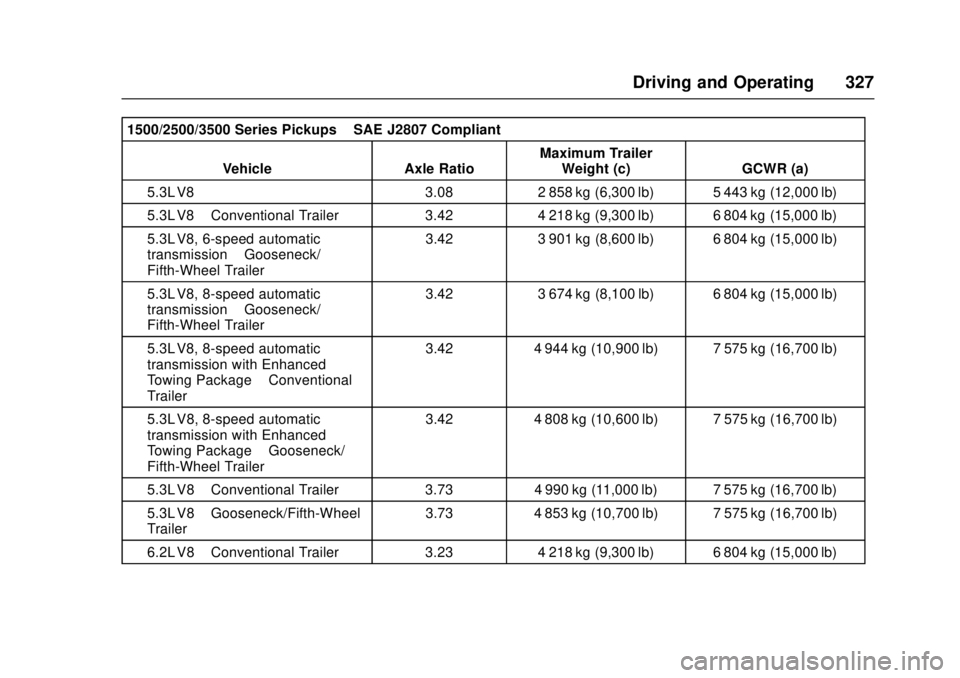
GMC Sierra/Sierra Denali Owner Manual (GMNA-Localizing-U.S./Canada/
Mexico-9955992) - 2017 - crc - 4/18/17
Driving and Operating 327
1500/2500/3500 Series Pickups–SAE J2807 Compliant
Vehicle Axle Ratio Maximum Trailer
Weight (c) GCWR (a)
5.3L V8 3.08 2 858 kg (6,300 lb) 5 443 kg (12,000 lb)
5.3L V8 –Conventional Trailer 3.424 218 kg (9,300 lb) 6 804 kg (15,000 lb)
5.3L V8, 6-speed automatic
transmission –Gooseneck/
Fifth-Wheel Trailer 3.42
3 901 kg (8,600 lb) 6 804 kg (15,000 lb)
5.3L V8, 8-speed automatic
transmission –Gooseneck/
Fifth-Wheel Trailer 3.42
3 674 kg (8,100 lb) 6 804 kg (15,000 lb)
5.3L V8, 8-speed automatic
transmission with Enhanced
Towing Package –Conventional
Trailer 3.42
4 944 kg (10,900 lb) 7 575 kg (16,700 lb)
5.3L V8, 8-speed automatic
transmission with Enhanced
Towing Package –Gooseneck/
Fifth-Wheel Trailer 3.42
4 808 kg (10,600 lb) 7 575 kg (16,700 lb)
5.3L V8 –Conventional Trailer 3.734 990 kg (11,000 lb) 7 575 kg (16,700 lb)
5.3L V8 –Gooseneck/Fifth-Wheel
Trailer 3.73
4 853 kg (10,700 lb) 7 575 kg (16,700 lb)
6.2L V8 –Conventional Trailer 3.234 218 kg (9,300 lb) 6 804 kg (15,000 lb)
Page 329 of 511
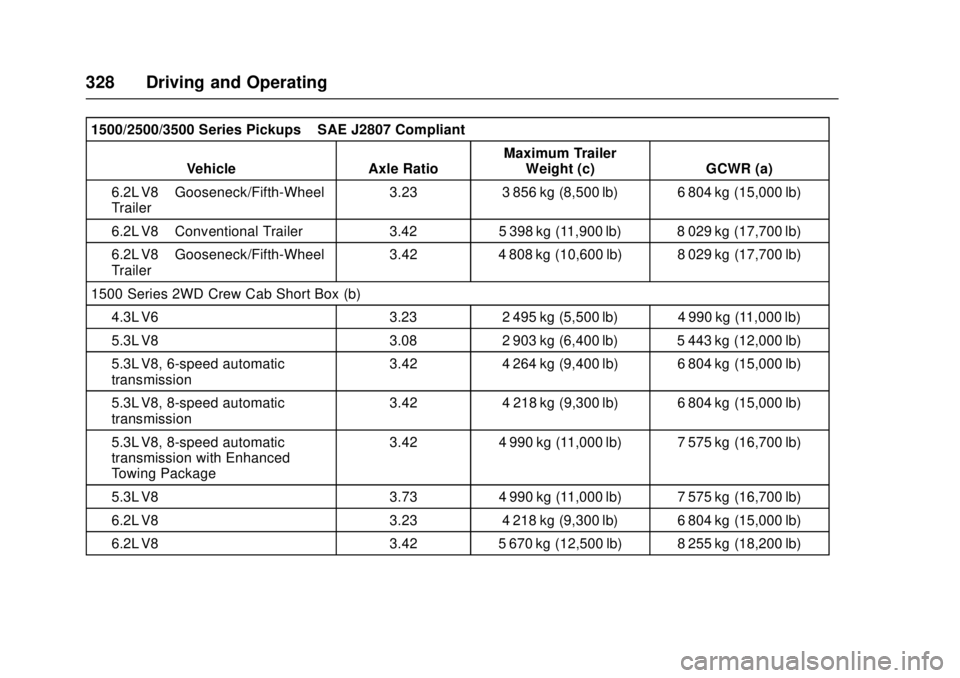
GMC Sierra/Sierra Denali Owner Manual (GMNA-Localizing-U.S./Canada/
Mexico-9955992) - 2017 - crc - 4/18/17
328 Driving and Operating
1500/2500/3500 Series Pickups–SAE J2807 Compliant
Vehicle Axle Ratio Maximum Trailer
Weight (c) GCWR (a)
6.2L V8 –Gooseneck/Fifth-Wheel
Trailer 3.23 3 856 kg (8,500 lb) 6 804 kg (15,000 lb)
6.2L V8 –Conventional Trailer 3.425 398 kg (11,900 lb) 8 029 kg (17,700 lb)
6.2L V8 –Gooseneck/Fifth-Wheel
Trailer 3.42
4 808 kg (10,600 lb) 8 029 kg (17,700 lb)
1500 Series 2WD Crew Cab Short Box (b) 4.3L V6 3.232 495 kg (5,500 lb) 4 990 kg (11,000 lb)
5.3L V8 3.082 903 kg (6,400 lb) 5 443 kg (12,000 lb)
5.3L V8, 6-speed automatic
transmission 3.42
4 264 kg (9,400 lb) 6 804 kg (15,000 lb)
5.3L V8, 8-speed automatic
transmission 3.42
4 218 kg (9,300 lb) 6 804 kg (15,000 lb)
5.3L V8, 8-speed automatic
transmission with Enhanced
Towing Package 3.42
4 990 kg (11,000 lb) 7 575 kg (16,700 lb)
5.3L V8 3.734 990 kg (11,000 lb) 7 575 kg (16,700 lb)
6.2L V8 3.234 218 kg (9,300 lb) 6 804 kg (15,000 lb)
6.2L V8 3.425 670 kg (12,500 lb) 8 255 kg (18,200 lb)
Page 330 of 511
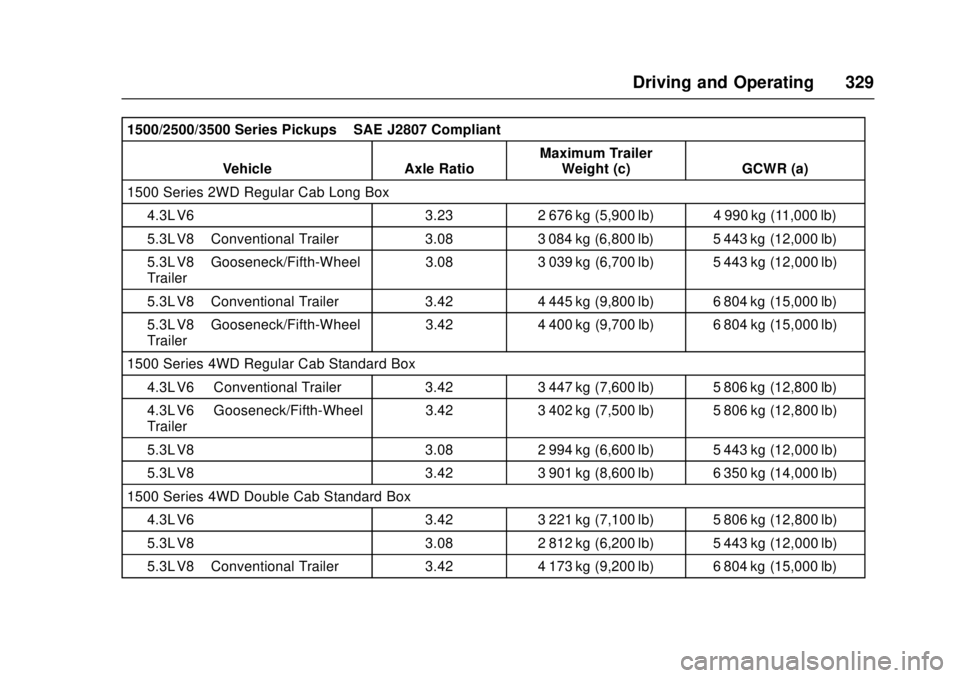
GMC Sierra/Sierra Denali Owner Manual (GMNA-Localizing-U.S./Canada/
Mexico-9955992) - 2017 - crc - 4/18/17
Driving and Operating 329
1500/2500/3500 Series Pickups–SAE J2807 Compliant
Vehicle Axle Ratio Maximum Trailer
Weight (c) GCWR (a)
1500 Series 2WD Regular Cab Long Box 4.3L V6 3.23 2 676 kg (5,900 lb) 4 990 kg (11,000 lb)
5.3L V8 –Conventional Trailer 3.08 3 084 kg (6,800 lb) 5 443 kg (12,000 lb)
5.3L V8 –Gooseneck/Fifth-Wheel
Trailer 3.08 3 039 kg (6,700 lb) 5 443 kg (12,000 lb)
5.3L V8 –Conventional Trailer 3.424 445 kg (9,800 lb) 6 804 kg (15,000 lb)
5.3L V8 –Gooseneck/Fifth-Wheel
Trailer 3.42
4 400 kg (9,700 lb) 6 804 kg (15,000 lb)
1500 Series 4WD Regular Cab Standard Box 4.3L V6 –Conventional Trailer 3.423 447 kg (7,600 lb) 5 806 kg (12,800 lb)
4.3L V6 –Gooseneck/Fifth-Wheel
Trailer 3.42
3 402 kg (7,500 lb) 5 806 kg (12,800 lb)
5.3L V8 3.082 994 kg (6,600 lb) 5 443 kg (12,000 lb)
5.3L V8 3.423 901 kg (8,600 lb) 6 350 kg (14,000 lb)
1500 Series 4WD Double Cab Standard Box 4.3L V6 3.423 221 kg (7,100 lb) 5 806 kg (12,800 lb)
5.3L V8 3.082 812 kg (6,200 lb) 5 443 kg (12,000 lb)
5.3L V8 –Conventional Trailer 3.424 173 kg (9,200 lb) 6 804 kg (15,000 lb)